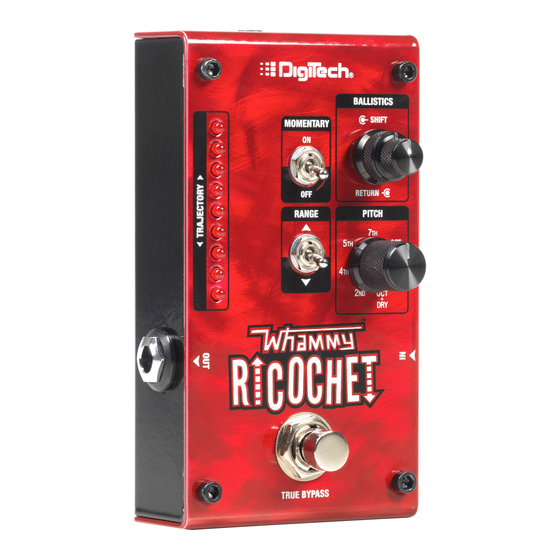
Table of Contents
Advertisement
Advertisement
Table of Contents

Summary of Contents for DigiTech whammy ricochet
- Page 1 Owner’s Manual...
-
Page 2: Warranty
The foregoing is in lieu of all other warranties, expressed or implied, and DigiTech neither assumes nor authorizes any person to assume any obligation or liability in connection with the sale of this product. In no event shall DigiTech or its dealers be liable for special or consequential damages or from any delay in the performance of this warranty due to causes beyond their control. - Page 3 • 2 OCTAVES • OCTAVE + DRY To use the Whammy Ricochet pedal, select the desired pitch shifting interval with the PITCH control then select the pitch direction with the RANGE switch. Set the Footswitch for momentary or latched operation using the MOMENTARY switch. To audition the rise and fall rate of the pitch shifting effect, turn the effect on/off using the Footswitch;...
-
Page 4: User Interface
USER INTERFACE 1. Power Connector Connect the specified Harman power adapter (sold separately) to this jack. Be sure to use the proper power adapter for your area’s mains line voltage. See “Specifications” on page 7 for power adapter model information. The Ricochet can only be powered using the external power adapter. - Page 5 Footswitch is pressed. NOTE: When the MOMENTARY switch is set to the “ON” position, the Whammy Ricochet will use a buffered bypass signal path. When the MOMENTARY switch is set to the “OFF” position, the Whammy Ricochet provides a hard-wired bypass signal path.
- Page 6 CLASSIC & CHORDS MODES The Whammy Ricochet provides two modes of operation: Classic mode (the classic Whammy algorithm) and Chords mode (the modern algorithm from the Whammy DT). The Classic mode is ideal for single note soloing while the Chords mode is best suited for bending of full chords. The default mode out of the box is Chords.
-
Page 7: Making Connections/Applying Power
HARMAN PS0913DC POWER ADAPTER (NOT INCLUDED) OTHER PEDALS OPTIONAL Use unbalanced TS instrument cables only. NOTE: The Whammy Ricochet should be the first pedal in your effects chain. Placing any effect in front of it may impact its pitch shifting performance. -
Page 8: Example Settings
EXAMPLE SETTINGS Try these settings to get started. Killing in the Name Of (Classic) Whole Step Stabs (Chords) 7 String (Chords) Dive Bombs (Classic) -
Page 9: Specifications
SPECIFICATIONS Electronic Sample Rate: 44.1kHz in classic mode, 22kHz in chords mode Frequency Response: 20 Hz–16 kHz (classic mode), 20 Hz–11 kHz (chords mode) Signal to Noise Ratio: > -106dB (A weighted); ref = max level, 22 kHz bandwidth THD: 0.004% @ 1 kHz;... - Page 10 PHONE: (801) 566-8800 PHONE: (801) 566-8800 WEB: WEB: digitech.com digitech.com SUPPORT: SUPPORT: digitech.com/en-US/support digitech.com/en-US/support Whammy Ricochet Owner’s Manual 5070671-A © 2016 Harman. All rights reserved. DigiTech is a registered trademark of Harman.













Need help?
Do you have a question about the whammy ricochet and is the answer not in the manual?
Questions and answers